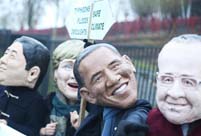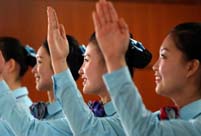Zhou Fanguo is a veteran steel plant worker in the northern port city of Tangshan, but he's thinking of becoming a truck driver in the future.
Zhou, 43, is preparing to learn a new skill, as the steel production line he has worked on for 15 years is facing closure.
Tangjia Iron and Steel Company, a private company with an annual production capacity of 1 million tons, is among 308 pollutant-discharge companies designated by the Tangshan municipal government to be shut down or reduce capacity due to failing to meet environmental standards.
Two out of the company's five production lines have been ordered to be shut down by the end of this year. Zhou's production line was targeted, and he is very likely to be laid off.
Tangshan, only 200 kilometers from Beijing, gained notoriety this year after earning a place on a list of top 10 most polluted Chinese cities for nine consecutive months, beating out all other cities in March, June and July, according to statistics from the Ministry of Environmental Protection.
The dishonorable title has upset the municipal government, and the city is now determined to control the pollution and transform its industrial structure, which has relied highly on steel, cement and coke production in past decades.
Tangshan plans to reduce the density of PM 2.5, a key indicator of air pollution, by about 33 percent from 2012 levels by the year 2017. It also plans to cut iron production capacity by 28 million tons and steel production capacity by 40 million tons, also by 2017.
The ensuing loss of tax revenues due to the capacity reduction could be as high as 37 billion yuan (6.03 billion U.S. dollars) in coming years, said Jiang Deguo, secretary of the Communist Party of China Tangshan municipal committee.
"We need to speed up the economic transformation and create new growth points to ensure the stable and healthy development of the economy and society," he said.
"If we only do 'subtraction' and don't do 'addition,' the economy will be stalled and society will lose its foundation of stability," he added.
Further development of industries that consume steel and the promotion of high-tech, advanced equipment manufacturing and energy-saving industries have been regarded as "additions" that could offset the losses.
Economic restructuring will never be an easy task for the government, enterprises, or ordinary people like Zhou.
"The treatment of air pollution determines the life and death of Tangshan," said Jiang. "There will be pain in the process, but we have no way to turn back."
GROWING GDP, FALLING INCOME
With robust growth of heavy industry, Tangshan's Gross Domestic Product (GDP) exceeded 100 billion yuan in 2001 and increased fivefold to 500 billion yuan ten years later.
The port city, with a population of 7.6 million, was ranked 19th out of major Chinese cities in terms of GDP in 2012, and its GDP is expected to surpass 600 billion yuan this year, according to Chen Xuejun, the city's mayor.
Tangshan produces one-eighth of China's steel, three percent of China's cement, 13 percent of China's coking products and 0.8 percent of China's electricity, which have propped up economic growth but brought harm to the environment, said Chen.
The sulfur dioxide and nitric oxide the city discharged in 2012 amounted to 318,000 tons and 390,000 tons, respectively, accounting for 1.5 percent and 1.7 percent of China's total.
In the first nine months of the year, people in Tangshan had only 75 days with air that was safe to breathe according to the national standard.
Meanwhile, the robust GDP growth has not necessarily brought more wealth to locals like Zhou.
Zhou had a monthly salary of about 700 yuan in 1998, when he first joined the steel company, a decent income at that time. It rose to more than 3,000 yuan around 2006.
However, things began to change after 2008, when the global financial crisis soured the world economy and China slowed down its pace of growth.
The profit from a tonne of steel was worth the price of a cell phone several years ago, but devalued to the price of a kilogram of pork two years ago, and was worth only the price of a bottle of water last year. Profits from one tonne of steel weakened further to 0.43 yuan in the first half of this year due to serious overcapacity and sluggish demand, according to Jiang Deguo.
Zhou's monthly salary has dropped to less than 2,000 yuan as his steel company has faced serious losses. It is hard for Zhou to make ends meet, with a child in high school and a jobless wife to support.
Reducing steel production capacity by the 40 million tonnes designated by the municipal government, almost one-third of the total, will involve the resettlement of more than 400,000 people directly or indirectly engaged in the industry, said Jiang.
It will be a pressing task for the government to help foster new areas of growth to keep people employed.
TRANSFORMATION ENDEAVOR
Saturated markets, limited resources, a deteriorating environment and the public's expectations for clean air have forced the Tangshan municipal government to act.
An irrational industrial structure caused the environmental problems, especially the air pollution, said Jiang.
Steel companies in Tangshan are trying to consume more steel locally and extend the production chain through deep processing.
A total of 82 steel deep processing projects with a total investment of 52.53 billion yuan are expected to consume 10.3 million tons of steel this year and contribute 16.38 billion yuan in taxes, according to Tangshan's mayor, Chen Xuejun.
The government is dedicated to improving the share of the tertiary industry to 36 percent in its industry portfolio by 2016.
Tangshan will invest 148.7 billion yuan in more than 150 service projects within three years, including port logistics, financial services, trade and tourism, medical care, and elderly care to create 300 billion yuan in added value, said Chen.
Tangshan Iron and Steel Co., Ltd., the largest iron and steel producer in the city, is aiming for the non-steel sectors for survival.
Since 2010, 16,000 workers, nearly half of the company's total payroll, have been resettled in 22 non-steel affiliated companies in the sectors of LED manufacturing, logistics, information automation and liquefied natural gas.
"Our company will be a comprehensive industrial enterprise in the future, with steel as the basis," said Yu Yong, the company's chairman.
By 2015, 22,000 staff of the company will be engaged in non-steel industries, and revenues from the non-steel sectors will surpass those of the steel sector, he said.
Tangshan has paid a huge environmental cost for its inefficient growth model. It is the right time to transform its industrial structure, said Xue Zhimin, deputy director of the Hebei provincial government research office.
The government should use strict environmental standards as a threshold to eliminate outdated capacity and speed up the industrial upgrade, said Xue.
But for medium and small companies like Tangjia Iron and Steel Company, which have far less capital to invest, the road to transformation is daunting.
A company executive said on condition of anonymity that he hoped the government could compensate their losses from capacity reduction and provide funding as well as preferential tax policies to start new businesses.
 Finland has more eggs in the Chinese basket than any other
Finland has more eggs in the Chinese basket than any other In pictures: PLA's digital equipment
In pictures: PLA's digital equipment  Protesters demonstrate during UN Climate Change Conference in Poland
Protesters demonstrate during UN Climate Change Conference in Poland  Self-made farmer billionaire donates 69 villas at hometown
Self-made farmer billionaire donates 69 villas at hometown Demolition of bizarre rooftop villa in Beijing still in progress
Demolition of bizarre rooftop villa in Beijing still in progress Service seminar for E China train attendants
Service seminar for E China train attendants  Supermodel-turned-designer
Supermodel-turned-designer Cheerleaders light up CBA regular season
Cheerleaders light up CBA regular season  Finland--anytime you want is right time to go: Ambassador
Finland--anytime you want is right time to go: Ambassador Maritime counter-terrorism drill
Maritime counter-terrorism drill College students want partner for sex needs
College students want partner for sex needs Models dazzle at Int'l Yacht Model Pageant
Models dazzle at Int'l Yacht Model Pageant  How to apply for a green card in China
How to apply for a green card in China National Geographic Traveler Photo Contest
National Geographic Traveler Photo Contest Weekly Sports Photos
Weekly Sports PhotosDay|Week|Month